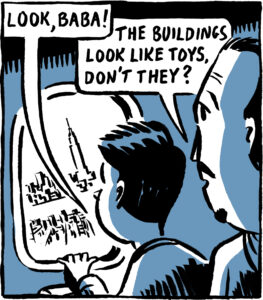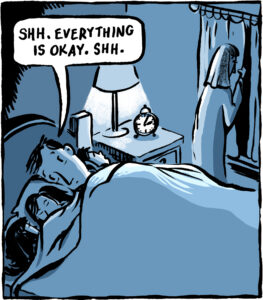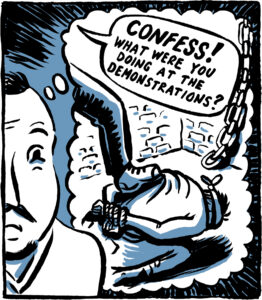Experimenting with visual storytelling formats can allow a newsroom to rise above the clutter by taking a fresh angle to news topics. Last January, The New York Times did that by launching Welcome to the New World, a fully reported graphic narrative. It is the first series of its kind, according to editor Bruce Headlam.
The comic follows two Syrian brothers and their families, who entered the United States on Election Day 2016. Although the family members’ names and location are protected, everything that happens to their characters is a true account of their lives in close to real time.

From “Should We Stay or Should We Go?” | Illustrations courtesy Jake Halpern and Michael Sloan
New World is published in the Sunday Review and online in biweekly installments of eight-panel comic strips. Its creators are author Jake Halpern and illustrator Michael Sloan. We talked with Halpern about how the series is made, the advantages and challenges of using a new storytelling format, and the importance of visual storytelling in journalism today.
You’ve been in many professional areas: journalism, fiction writing, and now comic writing. How did your varied background help as you started writing New World?
At first glance, there’s nothing in common between all the different things I do, but the commonality is storytelling. At the core of all this is how to tell a story where you build characters and build narrative tension. Whether I’m writing a New Yorker story or a Young Adult (YA) novel, I’m thinking about what the plot points are.
Weirdly, the YA fiction was really helpful making me think about how story works, because YA fiction —at least the stuff I write — is heavily plot. So I feel like in some ways what I really am is a storyteller. That’s the way I approach the comic too, as just another way of telling a story but the principles are the same: build the narrative tension and build the characters and make them likable.
What is New World’s production process?
I go out to visit the family wherever they are on a pretty regular basis. Sometimes I gather material and sometimes I just hang out with the family. Part of the project is just having a relationship with them and being there. I take notes, interview them pretty in-depth, come back and think about the story and its most boiled-down essence of the plot points.
Then I take a stab at writing a script based on the notes that I’ve taken. I send the script to Bruce; sometimes he’ll make very small edits and sometimes he’ll come back and say, “I think you need to go back to the drawing board on this.” When he likes the script, I send it to Michael to do a pencil sketch and I simultaneously send a script to my translator who translates the script for the family. So Michael makes the pencil sketch, then Bruce, the art director and Rachel Dry are looking at the pencil sketch, the sketch gets copyedited and it goes back to Michael and he inks it.
I would never give a subject a draft of what I’ve written about them in print journalism. But because there’s a language barrier here, and because this is kind of a vulnerable population, I really want to make every possible effort to make sure that I’m being fair and accurate to them.
What are the strengths and constraints of using graphic narration when covering Syrian refugee issues?
The idea of a graphic narrative, where you can read it in about 60 seconds but somehow have it resonate on an emotional level in a way a more straight-news story couldn’t do, was very appealing to me. It was a challenge — I didn’t know if we could do it, but it seemed like it would be a really cool way to blow a breath of life into refugee issues.
One challenge is the graphic narrative in general: Almost everything has to be done in dialogue or picture, so it’s hard to explain things. It’s hard to explain the process of how much money refugees get from the government or how long they have to find a job or how they found housing. It all has to be done by dialogue.
A lot of times I wish I had more space — more panels to delve in deeper so you could see a little bit more the rhythm of the family’s life and also tell the story. I think also because the strip appears in the Sunday Review, there’s definitely pressure to keep it “newsy,” current events-focused. But there’s just a lot of storytelling moments that I’m missing and if I had more space I could tell them.
The strengths are these quiet visual moments that speak more than words could. In the May 27 installment, the FBI agent is visiting their house in response to the death threat they received. You see the image of the FBI agent leaving them on their own and you feel their aloneness in that moment. You can imagine being in their shoes and wanting this guy to stay with you to keep you safe, and you see him walking down the walkway and leaving them. Visually, their fragility and their aloneness is very palpable in a way I that don’t necessarily think I could achieve if I was just using words. So there’s a cinematic quality to it.
What misconceptions have others had about New World?
Occasionally I talk to people who think it’s loosely based on a true story. When it runs in the Times, it says something like, “A true story,” but people aren’t expecting a cartoon format to adhere strictly to the truth. Given what I’ve explained about what lengths I’ve gone to, people sometimes are surprised. I think that’s a little bit of a challenge because people aren’t used to getting news or journalistic reporting in this format.
I don’t think that even my fellow journalists probably appreciate the amount of reporting that goes into it. They also don’t understand that it’s happening in real-time, which is maybe something that we should make clearer. I think people think I went and found this family and I interviewed them a few times and I’m just spacing the timeline out. I’m really visiting them and checking in with them almost every week. And you’re getting updates on them in real time. So I think that all that — sometimes it’s lost, sometimes it’s not. But that’s the challenge of a new format.
What is the importance of visual storytelling in this era, especially when it comes to news?
People talk about how attention spans are getting shorter and shorter and how people don’t have time to read or an interest in reading super in-depth reporting. It’s kind of sad if that’s true, but I will say one really nice feature of a graphic narrative like this is that it takes almost no time. My wife will read new installments and I will watch her read it in literally 30 seconds. There is value in that it’s not a big time commitment.
The other thing is that it appeals to a very wide audience. It is a New York Times production, but I hoped that maybe the accessibility of it gives it a wider reach than those who read the Times, especially online. It’s great — the refugees who I’m writing about, even with their somewhat limited grasp of written English, can read it. So the advantage of few words and visual images is that it expands the realm of people who can process it and appreciate it.
There’s a scene in the the first installment where the dad has a flashback to basically being tortured in Syria. And my son who’s 10 was able to get what was going on in that scene and appreciate the seriousness and gravity and sadness of it, but it wasn’t so gruesome that he was going to be horribly upset or traumatized by it. And so I think if you would have described a torture scene in print it would have been somehow more disturbing, really. There are ways that its format can make it — without watering it down — more accessible.
What can other newsrooms learn from New World about covering Syrian refugees in their communities?
One is that it requires investment. The Times supported us to do a long-term project where we follow the families over the course of many months. I think what happens is that there are layers to the story and you have to build up trust. And part of what’s happening with these two families is that because we’ve been following them for more than six months, they’ve really let us into their lives, and that allows us and the reader to have a deeper connection with them. But none of that’s possible if the news organization you’re working for doesn’t support the people who are doing it to spend that kind of time going into a deep dive.
The other thing is that, it seems obvious perhaps, but everyone has a story. Every one of these refugees has some sort of epic story. You know, you have to find someone who’s willing to tell it, but there’s an abundance of powerful narratives like this in towns wherever these folks are being resettled.
It’s not easy to sell the reader into reading a story that they think is going to be a downer in a time where there’s already a lot of bad news. I think in some ways you need to lure the reader into these stories in different ways and then they’re surprised that they’re actually as invested as they are. The value of new formats is that people would be willing to try a narrative that otherwise they might not.
What have you learned from New World?
Clinging to the old format of, “This is how journalism is done and it doesn’t involve x, y and z,” I don’t think that’s a winning strategy at this point. Editors are going to have to take risks to come up with innovative ways to tell stories. If they do, they’re going to get followings and if they don’t, it’s going to be a kind of slow death.
You might also be interested in:
By sending data from their targeted audiences in Adobe Analytics into MFN, Crain was able to more clearly understand what topics, categories, and even story types were engaging readers in key parts of their coverage area.
Ways to support conversations for balancing innovation and stability in your news organization, essential considerations about this often overlooked topic, and guidance to include them in your technology decisions.
Successfully and efficiently marketing your work can be hard, especially for local news teams with limited resources, but marketing yourself to your audience is an essential skill for news organizations to drive revenue and promote sustainability.







